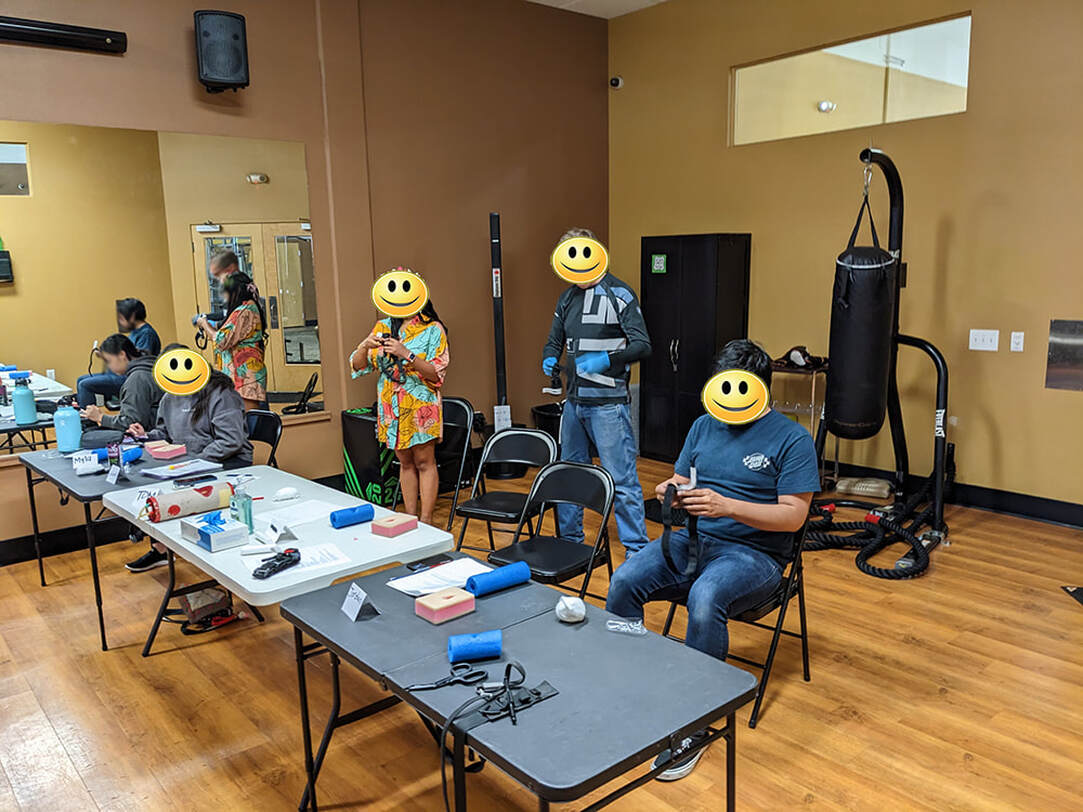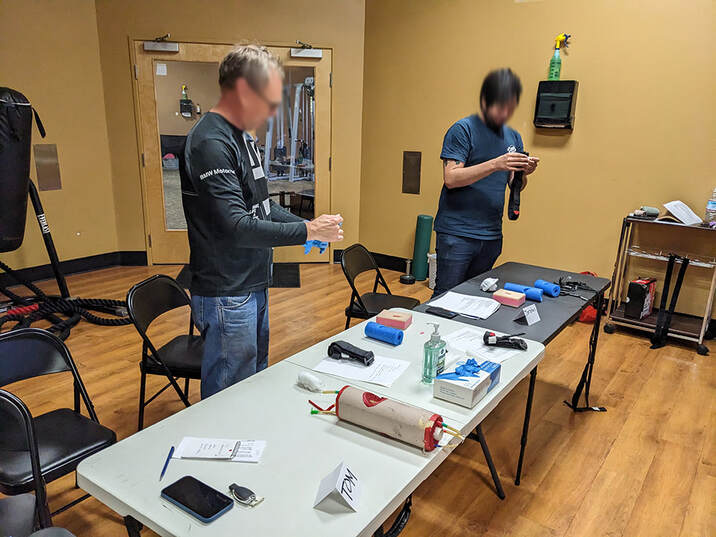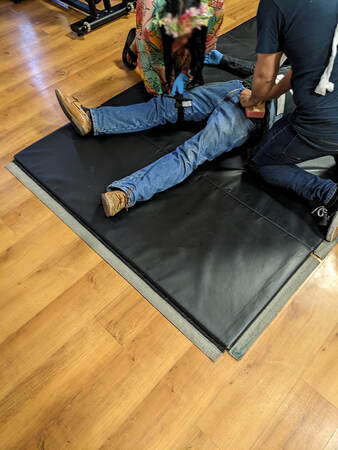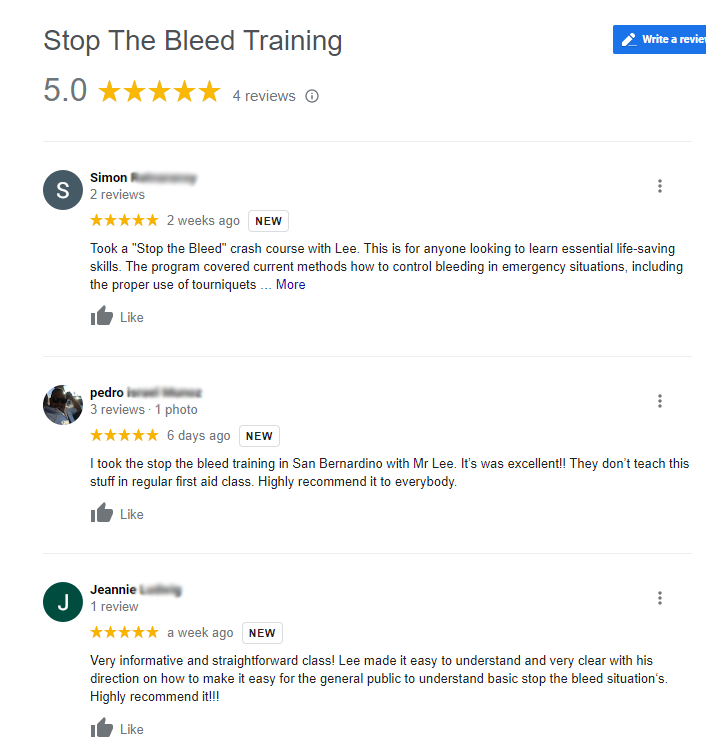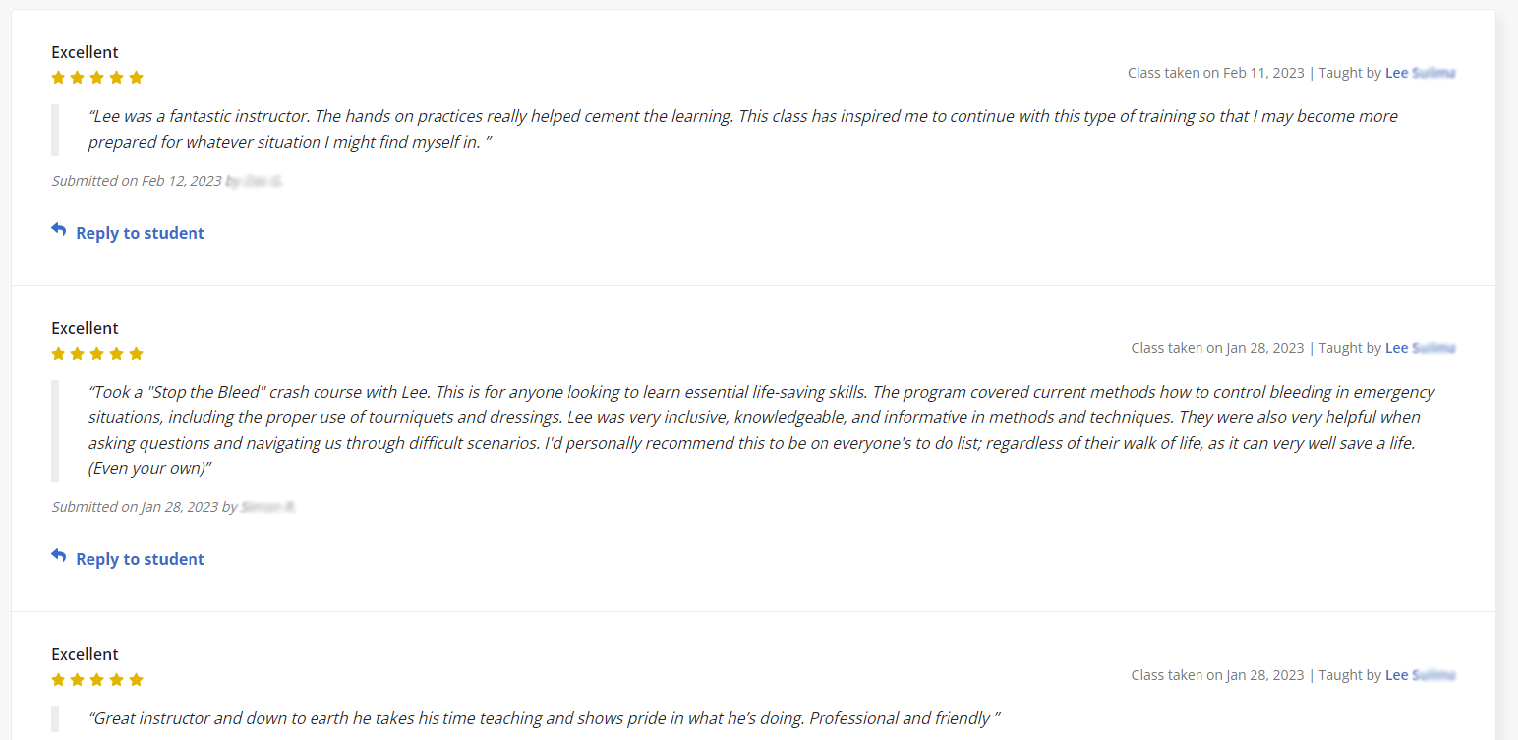GET CERTIFIED
In Home / Office
Private Training Option
Orange County / Los Angels
$549.95 2 hr class
Up to 10 students
$997 4 hr class
Up to 10 students
Drive fee may apply
(951) 356-6851
Private Training Option
Orange County / Los Angels
$549.95 2 hr class
Up to 10 students
$997 4 hr class
Up to 10 students
Drive fee may apply
(951) 356-6851
Schedule of upcoming classes open to the public:
Next class open to the public will take place in Corona in
August. Information will be posted after training facility is booked.
Thank you
Next class open to the public will take place in Corona in
August. Information will be posted after training facility is booked.
Thank you
Would you like to host a class?
Contact us for more details
Contact us for more details
If professional help is 8 minutes away
and you only have 3 minutes to Save A Life,
do you know what to do?
and you only have 3 minutes to Save A Life,
do you know what to do?
What does a student learn in a basic stop the bleed class?
A basic Stop the Bleed class typically teaches students how to recognize and respond to life-threatening bleeding. Students will learn how to use tourniquets and other bleeding control techniques to stop bleeding and potentially save lives.
Here are some specific topics that may be covered in a basic Stop the Bleed class:
A basic Stop the Bleed class typically teaches students how to recognize and respond to life-threatening bleeding. Students will learn how to use tourniquets and other bleeding control techniques to stop bleeding and potentially save lives.
Here are some specific topics that may be covered in a basic Stop the Bleed class:
- The importance of bleeding control: Students will learn about the role of bleeding control in saving lives and the statistics surrounding bleeding injuries.
- How to recognize life-threatening bleeding: Students will learn how to identify signs of severe bleeding, including the location and severity of the wound.
- Basic anatomy: Students will learn about the major arteries and veins in the body and how they can be used to control bleeding.
- Tourniquet use: Students will learn how to properly apply a tourniquet to control bleeding in an arm or leg.
- Other bleeding control techniques: Students may also learn about other techniques for controlling bleeding, such as using direct pressure or packing a wound.
- Hands-on practice: Students will typically have the opportunity to practice these skills through hands-on exercises and simulations.
What happens if someone is loosing a lot of blood?
The amount of time a person has to live if serious blood loss occurs can vary depending on a number of factors, including the location and severity of the bleeding, the person's age and overall health, and the availability of medical treatment.
In general, if a person is bleeding severely and does not receive medical treatment, they may only have a few minutes to a few hours to live. Uncontrolled bleeding is a leading cause of preventable death in traumatic injuries, and prompt medical attention is critical to survival.
That being said, there are many cases where people have survived severe blood loss with proper medical treatment. For example, a person who is bleeding severely from an arm or leg injury may be treated with a tourniquet to stop the bleeding, followed by surgery to repair the damaged blood vessels. In this case, the person's chances of survival may be much higher.
Overall, it is important to recognize the signs of severe bleeding and seek medical attention as soon as possible in order to increase the chances of survival.
The amount of time a person has to live if serious blood loss occurs can vary depending on a number of factors, including the location and severity of the bleeding, the person's age and overall health, and the availability of medical treatment.
In general, if a person is bleeding severely and does not receive medical treatment, they may only have a few minutes to a few hours to live. Uncontrolled bleeding is a leading cause of preventable death in traumatic injuries, and prompt medical attention is critical to survival.
That being said, there are many cases where people have survived severe blood loss with proper medical treatment. For example, a person who is bleeding severely from an arm or leg injury may be treated with a tourniquet to stop the bleeding, followed by surgery to repair the damaged blood vessels. In this case, the person's chances of survival may be much higher.
Overall, it is important to recognize the signs of severe bleeding and seek medical attention as soon as possible in order to increase the chances of survival.
Stop the Bleed is a national awareness campaign and call-to-action. The goal of the campaign is to cultivate grassroots efforts that encourage bystanders to become trained, equipped, and empowered to help in a bleeding emergency before professional help arrives.
Stop the Bleed training teaches individuals how to recognize and respond to life-threatening bleeding, including how to use tourniquets and other bleeding control techniques. The training is designed for anyone who may be the first on the scene of an emergency, including teachers, students, security guards, and other community members.
The Stop the Bleed campaign was launched by the White House in 2015 in response to the mass shooting at Sandy Hook Elementary School. The campaign is led by the American College of Surgeons and supported by a coalition of federal agencies, professional organizations, and industry partners.
Stop the Bleed training is typically provided by local law enforcement agencies, hospitals, and other organizations. The training is usually free of charge and takes about an hour to complete. To find a Stop the Bleed training near you, you can visit the Stop the Bleed website and or click the link below if you live in one of the following areas: San Bernardino, Riverside, Los Angeles or Orange County.
Stop the Bleed training teaches individuals how to recognize and respond to life-threatening bleeding, including how to use tourniquets and other bleeding control techniques. The training is designed for anyone who may be the first on the scene of an emergency, including teachers, students, security guards, and other community members.
The Stop the Bleed campaign was launched by the White House in 2015 in response to the mass shooting at Sandy Hook Elementary School. The campaign is led by the American College of Surgeons and supported by a coalition of federal agencies, professional organizations, and industry partners.
Stop the Bleed training is typically provided by local law enforcement agencies, hospitals, and other organizations. The training is usually free of charge and takes about an hour to complete. To find a Stop the Bleed training near you, you can visit the Stop the Bleed website and or click the link below if you live in one of the following areas: San Bernardino, Riverside, Los Angeles or Orange County.
Stop the Bleed training is a good skill to have for several reasons:
- It can save lives: Uncontrolled bleeding is a leading cause of preventable death in traumatic injuries. By learning how to properly control bleeding, you can help to save the life of someone who is bleeding severely.
- It is easy to learn: The techniques taught in Stop the Bleed training are easy to learn and can be performed with minimal equipment. Anyone can learn how to control bleeding and potentially save a life.
- It empowers individuals to take action: In an emergency situation, it can be easy to feel helpless or unsure of what to do. Stop the Bleed training empowers individuals to take action and make a difference in a crisis situation.
- It can be used in a variety of situations: The skills learned in Stop the Bleed training can be applied in a variety of situations, including car accidents, natural disasters, and acts of violence.
There are many first aid skills that are useful to have in order to be prepared for emergencies. Here are a few examples:
- Basic life support: This includes CPR (cardiopulmonary resuscitation) and using an AED (automated external defibrillator). These skills can help to save the life of someone who is experiencing cardiac arrest.
- Wound care: Knowing how to properly clean and dress a wound can help to prevent infection and promote healing.
- Bleeding control: As mentioned earlier, uncontrolled bleeding is a leading cause of preventable death in traumatic injuries. Knowing how to control bleeding can help to save lives.
- Fracture and sprain management: Knowing how to properly splint a fracture or sprain can help to reduce pain and prevent further injury.
- Burns: Knowing how to properly care for a burn can help to prevent infection and promote healing.
- Allergic reactions: Knowing how to recognize and treat allergic reactions, including anaphylaxis, can be life-saving.
Why it is important to have a quality tourniquet?
It is important to have a quality tourniquet because a tourniquet is a life-saving tool that can be used to control bleeding in emergency situations. If someone is bleeding severely, especially from an arm or leg, a tourniquet can be used to apply pressure to the bleeding vessel and stop the flow of blood.
However, not all tourniquets are created equal. It is important to have a tourniquet that is durable, easy to use, and effective at controlling bleeding. Cheap or low-quality tourniquets may not be reliable in an emergency situation, and could potentially cause further injury.
Here are a few reasons why it is important to have a quality tourniquet:
It is important to have a quality tourniquet because a tourniquet is a life-saving tool that can be used to control bleeding in emergency situations. If someone is bleeding severely, especially from an arm or leg, a tourniquet can be used to apply pressure to the bleeding vessel and stop the flow of blood.
However, not all tourniquets are created equal. It is important to have a tourniquet that is durable, easy to use, and effective at controlling bleeding. Cheap or low-quality tourniquets may not be reliable in an emergency situation, and could potentially cause further injury.
Here are a few reasons why it is important to have a quality tourniquet:
- Reliability: A high-quality tourniquet is more likely to work effectively in an emergency situation. It should be easy to use, and should have the ability to apply enough pressure to effectively stop bleeding.
- Durability: A quality tourniquet should be able to withstand the demands of an emergency situation. It should be made of materials that are resistant to wear and tear, and should be able to withstand the forces needed to control bleeding.
- Ease of use: A quality tourniquet should be easy to use, even under the stress of an emergency situation. It should have clear instructions, and should be intuitive to apply.
Do you have a basic medical kit at home?
Having a medical kit at home can be helpful in the event of minor injuries or illnesses, and can also be useful in emergency situations. Here are some items that you may want to include in a medical kit for your home:
Having a medical kit at home can be helpful in the event of minor injuries or illnesses, and can also be useful in emergency situations. Here are some items that you may want to include in a medical kit for your home:
- Bandages: A variety of sizes and types of bandages, including adhesive bandages, gauze pads, and medical tape.
- Wound care supplies: Antiseptic wipes or spray, hydrogen peroxide, and antibiotic ointment.
- Cold packs: For reducing swelling and relieving pain.
- Pain medication: Over-the-counter pain medication such as acetaminophen or ibuprofen.
- Allergy medication: Antihistamines for allergic reactions.
- Thermometer: To check for fever.
- Scissors and tweezers: For removing splinters or cutting bandages.
- Flashlight: For examining wounds or checking pupils.
- First aid manual: A guide to basic first aid and emergency care.
Why Get Training?
Stop The Bleed Training is designed to teach basic skills and empower individuals with knowledge that improves the probability of survival before professional help arrives. If a professional emergency responder is not on the scene of an emergency, every second counts. A person who is bleeding, may die in under five minutes if blood loss is not stopped. Providing first aid may save a life. We hope that you take the time to learn these basics skills and become certified in Stop The Bleed.
What Is A Basic Stop The Bleed Class ?
In a basic course, students learn three hands on techniques:
- How to apply pressure to a wound with the use of hands
- How to pack a wound to control the bleeding
- How to apply a tourniquet correctly
Who We train:
Teachers
Law Enforcement
Corporate sector
Retail personnel
Restaurant Industry
Construction personnel
Transportation sector
ROTC
JROTC
Church security teams
Other
Law Enforcement
Corporate sector
Retail personnel
Restaurant Industry
Construction personnel
Transportation sector
ROTC
JROTC
Church security teams
Other
About Us
Stop The Bleed Training California follows the curriculum according to Stop The Bleed®, which was created by the American College of Surgeons on Trauma in 2012. Over 90% of the training is conducted at different locations which include but are not limited to Orange County, San Bernardino County, Los Angeles County, Riverside County, Ventura County and San Diego County.
Due to limited resources we try to provide as much free training as we can to local schools, churches and Law Enforcement.
Due to limited resources we try to provide as much free training as we can to local schools, churches and Law Enforcement.

